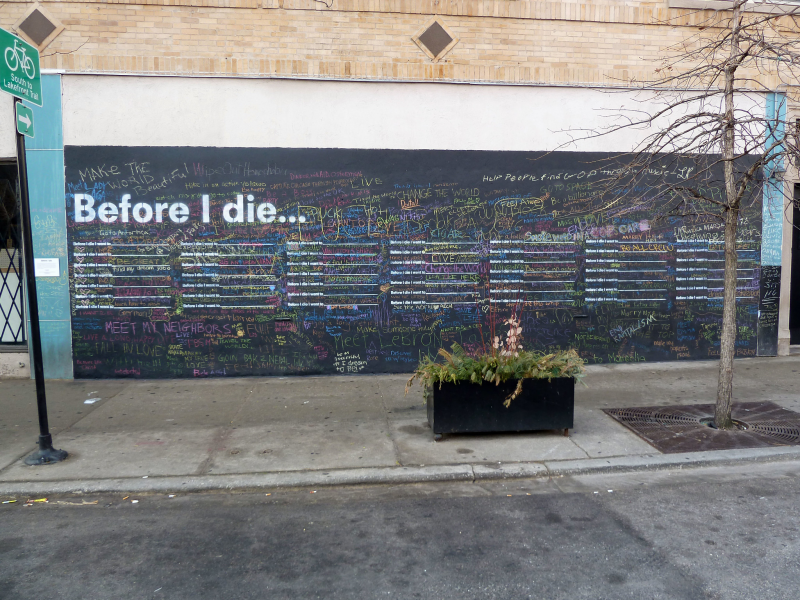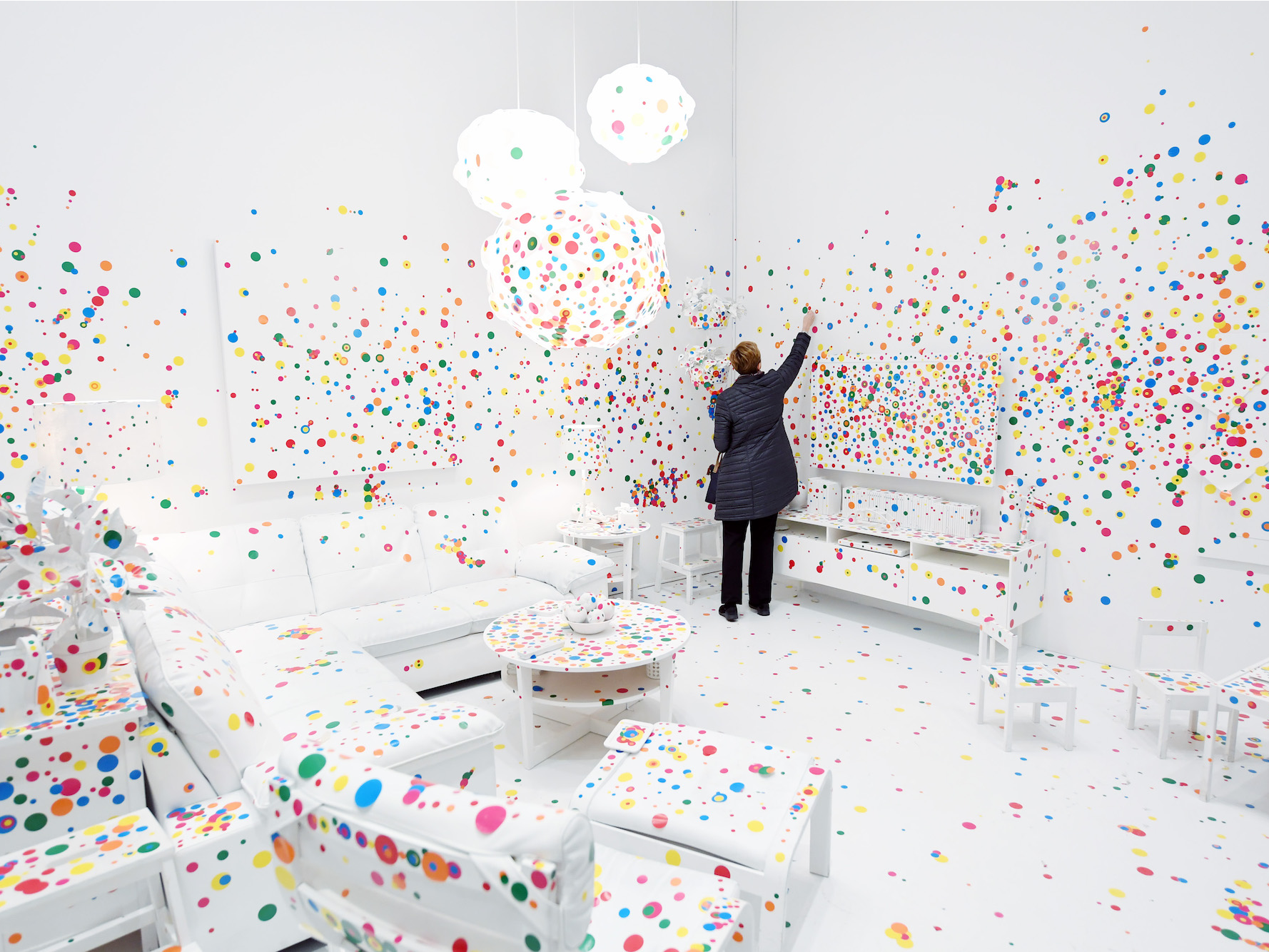- Art doesn’t always need to be a painting on the wall or a monument that stands still.
- It can also be an interactive installation that grows larger, or even smaller, such as “Untitled” (Portrait of Ross in L.A.) by Felix Gonzalez-Torres.
- From Candy Chang’s “Confessions” to Yayoi Kusama’s “Obliteration Room,” here are the most creative pieces of art that transform over time.
- Visit Insider’s homepage for more stories.
Art doesn’t have to be a painting on the wall. It can be a dynamic piece that grows larger, smaller, fuller, or emptier in order to convey its message. Oftentimes, art is even interactive.
From Felix Gonzalez-Torres’ “Untitled” to The Obliteration Room by Yayoi Kusama, these art pieces and installations change over time, either by their own design or through audience participation.
‘Untitled’ (Portrait of Ross in L.A.) is a 175-pound pile of candy that diminishes over time

Felix Gonzalez-Torres’s piece, “Untitled” (Portrait of Ross in L.A.), is a 175-pound pile of wrapped candies from which museum-goers are encouraged to take and eat pieces. The 175 pounds is meant to represent the healthy bodyweight of the artist’s partner, Ross Laycock, before he died of complications from AIDS. The diminishing aspect of the pile represents Laycock’s decline. In 1996, Gonzalez-Torres also died from AIDS at the age of 38.
The installation has been changing and morphing since 1991, as it is up to the museum to replenish the pile as they see fit.
Another Felix Gonzalez-Torres creation features two synchronized clocks that eventually fall out of sync

"Untitled" (Perfect Lovers), also by Felix Gonzalez-Torres, features two identical, synchronized clocks that tick side-by-side until they inevitably fall out of sync. One of the clock batteries will die before the other, symbolizing the relationship between Gonzalez-Torres and his partner Laycock. The artist created the installation in 1991 when Laycock was dying of AIDS-related complications.
Although the art piece looks slightly different in every museum, the artist did have a few rules, including that the commercial clocks be the same style and size. Additionally, the clocks can fall out of sync, but if one stops, it must be fixed or replaced.
'The Obliteration Room' is a white space that is gradually covered in color

First displayed in 2002, Yayoi Kusama's simple, yet eye-catching, installation is an all-white, domestic room waiting to be "obliterated" by visitors with brightly-colored stickers.
After being given sheets of colorful dots, visitors to "The Obliteration Room" are encouraged to transform the space together, covering the walls and furniture in stickers. Over the course of the installation, it changes from a blank white space to a multi-colored playroom.
Yayoi Kusama's 'Flower Obsession' is another colorful installation
http://instagr.am/p/BhSKHdqHeEL
Similar to "The Obliteration Room," Yayoi Kusama's "Flower Obsession" invites visitors to leave artificial gerbera daisies and flower stickers wherever they'd like in the room.
Over the course of four months, it becomes an explosion of red florals. Kusama's story for the piece came from her childhood.
"One day, after gazing at a pattern of red flowers on the tablecloth, I looked up to see that the ceiling, the windows, and the columns seemed to be plastered with the same red floral pattern," Kusama said in a press release. "I saw the entire room, my entire body, and the entire universe covered with red flowers, and in that instant, my soul was obliterated … This was not an illusion but reality itself."
Blake Fall-Conroy's art piece lets you work for minimum wage
http://instagr.am/p/BKI4SoLA7gI
Blake Fall-Conroy's "Minimum Wage Machine (Work in Progress)" changes depending on the minimum wage.
In 2018, turning the crank on this wooden box would have given you one penny every 3.24 seconds to represent the New York minimum wage at the time, which was $11.10 per hour. The mechanism is meant to be reprogrammed in different locations or whenever the wage changes.
Fall-Conroy's day job at a gas station served as inspiration. "I was bored all of the time. There was an old clock on the wall and I would watch the second hand go by and count out each penny I was earning," he said. "It seems crazy that anyone's time could be worth so little."
The artist hopes it offers a simulation of "the feeling of what it's like to work for minimum wage."
Read more: 53 disappointing photos that show what famous art is really like
This helium balloon from Karina Smigla-Bobinski is used to create drawings

Created by Polish-German artist Karina Smigla-Bobinski, "ADA" is an interactive installation featuring a helium balloon that floats in an all-white room. Visitors are encouraged to bounce the balloon around in order to make patterns on the walls.
Measuring three feet in diameter, the helium balloon has 300 charcoal sticks attached to it for drawing. The balloon was inspired by the 19th-century mathematician Ada Lovelace who, according to Smigla-Bobinski, "wrote a series of notes on her friend Charles Babbages's project 'analytical engine,' a computer with the ability to produce art."
The artist explained that for each exhibition she builds a new ADA, as "each ADA only has one life."
You can mark your height in an art piece titled 'Measuring the Universe'

In "Measuring the Universe," guests are invited to mark their heights in a white room - a large-scale take on what many parents do for their children when they're growing up.
Slovakian artist Roman Ondák asks for visitors to record their first name and the date of the measurement at their height line. Over time, the installation transforms from a blank space into an art piece representative of thousands of people.
Candy Chang's 'Confessions' has appeared in multiple cities
http://instagr.am/p/BUpWggxg_OA
Candy Chang's "Confessions," which is inspired by the practices of Catholicism and Japanese Shinto prayer walls, invites visitors to enter a private booth where they can write down their confessions on a wooden plaque. Chang then arranges the anonymous plaques on the gallery walls. The display of confessions features everything from "I eat too much cheese" to "I'm afraid to die alone."
The installation was first unveiled in 2012 at The Cosmopolitan's P3 Studio gallery in Las Vegas, Nevada, but has since been featured in other cities, including San Diego, California, in 2019.
The 'Star Sower' monument changes from day to night

This sculpture of a grain sower in Kaunas, Lithuania, doesn't look like much during the day, but it comes alive at night.
The original sculpture was created by Bernardas Bučas and was known only as "Sower" until a street artist who goes by Morfai covered the wall in stars. When the sun goes down, it appears as though the monument's shadow is sowing them.
There's a less anonymous confessional where you can write in your dreams

Candy Chang's more public piece is a large-scale wall where people can finish the sentence, "Before I die ..."
When she put up the first wall in New Orleans in 2011, it was completely filled in by the next day. Over 5,000 of these projects have since been created by communities in over 75 countries, including Iraq, China, Brazil, and Kazakhstan, with wishes ranging from "Before I die, I want to own a boat" to "Before I die, I want to tell my mother I love her."
- Read more:
- A man left his job and sold everything to buy a camera. Now he takes stunning photos of flowers trapped in ice that look like paintings.
- You probably had no idea that there are secret images hidden in these 14 famous works of art
- An artist uses spray paint to 'carve' through walls, and the see-through murals make for wild optical illusions
- This French artist transforms famous landmarks into optical illusions
